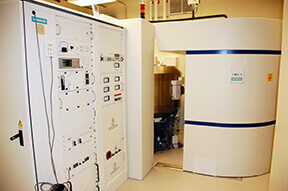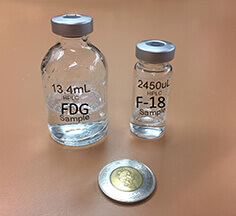Winnipeg Cyclotron Facility
About the facility
The opening of the Winnipeg Cyclotron Facility (WCF) in 2010 doubled the HSC Winnipeg’s capacity to provide PET scans. Prior to this, medical isotopes used in HSC’s PET/CT scanner were flown in each day from Edmonton or Montreal.
WCF is equipped with a Siemens Eclipse Dual Beam HP cyclotron – a self-shielded, 11 MeV, negative ion, particle accelerator.
The cyclotron produces medical isotopes used for Positron Emission Tomography (PET), a non-invasive imaging technology that allows examination of metabolic activity in the brain, heart, liver, tumours and muscle tissue. The medical isotopes produced have short half-lives which vary but are all less than 110 minutes.
Additionally, the cyclotron enables researchers at HSC Winnipeg, the universities of Manitoba and Winnipeg, and CancerCare Manitoba, to explore and develop new applications for diagnosis and treatment of diseases like Alzheimer’s, Parkinson’s, and congestive heart failure.
Construction on the facility began in 2006, with the cyclotron itself installed in 2008. After receiving Health Canada approval for its use, the first patient received treatment with locally-produced isotopes on August 10, 2010.
How the Cyclotron Works

The cyclotron is a particle accelerator that features a vacuum chamber and a strong magnet. The vacuum chamber is heavily shielded, with operations conducted from a separate room. There also is a “clean lab” where the original isotopes produced by the cyclotron are converted into the trace sugars used with the PET / CT scanners.
In the cyclotron, a high-frequency alternating voltage applied across the “D” electrodes alternately attracts and repels charged particles. The particles, injected near the centre of the magnetic field, accelerate only when passing through the gap between the electrodes. The perpendicular magnetic field, combined with the increasing energy of the particles, forces the particles to travel in a spiral path.

The spiral beam of particles widens and hits one of the two targets located on either side of the vacuum chamber. The cyclotron at HSC Winnipeg contains eight such targets in two carousels. Cyclotron beams are used to bombard other atoms to produce short-lived positron-emitting medical isotopes suitable for use with the PET scanner.
The main isotope produced by our cyclotron is Fluorine-18 (F-18). F-18 has a half-life of approximately 110 minutes. Once produced in the cyclotron, the material is transferred to a shielded “hot cell” where it is run through sophisticated chemistry modules to produce the required biological tracers.
How the cyclotron video works video
How Cyclotron Products are Used
The Positron Emission Tomography (PET) scanner is a nuclear medicine imaging technique which produces three-dimensional images of processes inside the body. The system detects pairs of gamma rays which are emitted indirectly by the positron-emitting tracer. A radiotracer called Fluorodeoxyglucose (FDG) which is fluorinated glucose is produced in the cyclotron, and this FDG sugar is injected into patients to help identify the presence of cancer.
The accumulation of these tracers shown in the PET scan provide a look at metabolic activity in the tissues. As cancer cells generally use more energy than normal tissue, they take in the FDG sugar tracers as a form of energy, and that contrast is shown by the scans.
Most patients undergo their PET scan at the same time as a CT scan. Computer tomography (CT) generates a 3-D image of the inside of the body from a large series of two-dimensional X-rays taken around a single axis of rotation. By combining the two scans (CT for anatomy and PET for metabolic activity) the areas of abnormality in the PET scan can be pinpointed to the anatomy shown in the CT scan.
How cyclotron products are used video
Equipment and Facility Safety

The isotopes produced by the cyclotron have a relatively short half-life and quickly decay to products that are not radioactive. The volume of radioactivity regularly produced by the cyclotron is relatively small in scale. A typical production run of F-18 amounts to less than 3mL of F-18. Once processed into FDG, the final volume is 15mL (about the same volume as a single-serve coffee creamer).
As a device producing radioactivity, cyclotrons require licensing through the Canadian Nuclear Safety Commission (CNSC). Cyclotrons are not a new technology and the CNSC has extensive experience with ensuring safety of staff and the general public from cyclotron facilities across Canada.
For more information about the CNSC visit: nuclearsafety.gc.ca
The design of the entire cyclotron facility, including safety considerations for staff and the general public, has been reviewed and approved by the CNSC.
The facility has multiple levels of shielding, protection, and monitoring to ensure safe operation. The cyclotron itself has several built-in safety interlock systems that prevent the cyclotron from operating if all safety systems are not operational or engaged. In the event of a catastrophic event, such as an earthquake, the cyclotron safety systems will shut off the cyclotron with absolutely no risk of explosion or meltdown. It is important to note that the cyclotron cannot operate or produce radioactivity without electrical power.
All cyclotron safety systems are tested on a regular basis to ensure they are functioning according to design.
The CNSC conducts regular inspections of the facility’s radiation safety program to ensure safety and compliance with federal safety regulations.
Equipment and facility safety video
The Canadian Nuclear Safety Commission has excellent educational resources about radiation and radiation safety in Canada:
Documentation
Public Disclosures
- PUBLIC DISCLOSURE – WCF 13396-16 (Jan. 11, 2016)
- PUBLIC DISCLOSURE – WCF 13396-16 (Mar. 11, 2016)
Standard Operating Procedure
Contact Us
If you have questions about the Winnipeg Cyclotron Facility, please contact us at [email protected] or 204-787-3661 or toll-free 1-877-499-8774.
Sources: WRHA News, BC Cancer Agency (www.bccancer.bc.ca/our-services/services/pet-functional-imaging/pet-cyclotron-and-radiopharmacy-facility); used with permission.



